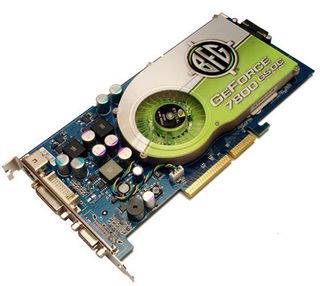AGP Platform Analysis, Part 1: New Cards, Old System
The New AGP Lineup, Continued
Geforce 7600 GT
Online Price: ~$185
Codename: G73, 90 nanometer technology
12 pixel shaders, 5 vertex shaders, 12 texture units, 8 raster operator units
128-bit memory bus
560 MHz core, 700 MHz DDR (1400 MHz effective) memory
The 7600 GT is an amazing card in this price range, sporting new SM 3.0 technology and very high clock speeds to deliver excellent performance. Its weakest feature is its 128-bit memory bus, but its high memory speeds offset that disadvantage and make it competitive with 256-bit cards like the X800 XT/X850 XT and even the 7800 GS.

Leadtek 7600 GT AGP
Our sample 7600 GT was provided by Leadtek. It also requires a Molex connector for power; the 7600 GT for PCI Express requires no separate power connector, but that's because the PCI Express bus provides more power than the AGP bus.
We should note that the only other company to manufacture the 7600 GT for AGP is XFX.
BFG 7800 GS OC
Online Price: ~$240
Codename: G70, 110 nanometer technology
16 pixel shaders, 6 vertex shaders, 16 texture nits, 8 raster operator units
256-bit memory bus
375 MHz core, 600 MHz DDR (1200 MHz effective) memory
The 7800 GS was a contender for the fastest AGP card title until the AGP versions of the 7600 GT and X1950 PRO showed up. It is essentially a stripped down 7800 GT, with 16 pipelines instead of 20.
Stay on the Cutting Edge
Join the experts who read Tom's Hardware for the inside track on enthusiast PC tech news — and have for over 25 years. We'll send breaking news and in-depth reviews of CPUs, GPUs, AI, maker hardware and more straight to your inbox.

BFG 7800 GS OC
The BFG flavor of the 7800 GS is factory overclocked, like most (if not all) of BFG's offerings. Both the core and memory speeds have been bumped up, to 400 MHz and 625 MHz respectively, to give the 7800 GS a slight edge over other 7800 GS cards. Let's see if this boost helps it against the other contenders.
Like most of the other cards, the 7800 GS OC requires one Molex connector for power.
Current page: The New AGP Lineup, Continued
Prev Page The New AGP Lineup Next Page The New AGP Lineup, Continued